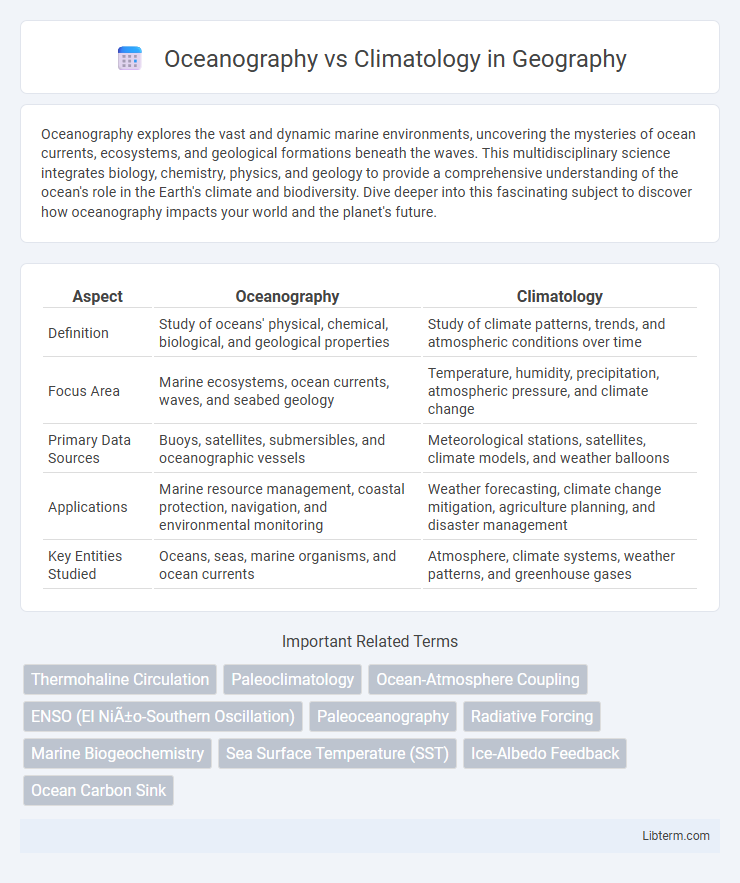Oceanography explores the vast and dynamic marine environments, uncovering the mysteries of ocean currents, ecosystems, and geological formations beneath the waves. This multidisciplinary science integrates biology, chemistry, physics, and geology to provide a comprehensive understanding of the ocean's role in the Earth's climate and biodiversity. Dive deeper into this fascinating subject to discover how oceanography impacts your world and the planet's future.
Table of Comparison
| Aspect | Oceanography | Climatology |
|---|---|---|
| Definition | Study of oceans' physical, chemical, biological, and geological properties | Study of climate patterns, trends, and atmospheric conditions over time |
| Focus Area | Marine ecosystems, ocean currents, waves, and seabed geology | Temperature, humidity, precipitation, atmospheric pressure, and climate change |
| Primary Data Sources | Buoys, satellites, submersibles, and oceanographic vessels | Meteorological stations, satellites, climate models, and weather balloons |
| Applications | Marine resource management, coastal protection, navigation, and environmental monitoring | Weather forecasting, climate change mitigation, agriculture planning, and disaster management |
| Key Entities Studied | Oceans, seas, marine organisms, and ocean currents | Atmosphere, climate systems, weather patterns, and greenhouse gases |
Overview of Oceanography and Climatology
Oceanography examines the physical, chemical, biological, and geological properties of oceans, emphasizing ocean currents, marine ecosystems, and seabed geology. Climatology studies atmospheric patterns and long-term weather trends, analyzing temperature, humidity, and precipitation to understand climate variability and change. Both fields interconnect through the ocean-atmosphere system, influencing global climate dynamics and environmental processes.
Key Differences Between Oceanography and Climatology
Oceanography studies the physical, chemical, biological, and geological aspects of the ocean, including marine ecosystems, ocean currents, and seafloor geology, while climatology focuses on atmospheric patterns, climate systems, and long-term weather trends affecting the Earth's climate. Oceanography relies heavily on tools like remote sensing, oceanographic vessels, and underwater sensors, whereas climatology utilizes climate models, weather stations, and satellite data for atmospheric analysis. Key differences lie in their primary subject matter--marine environments versus atmospheric phenomena--and their methodologies, with oceanography emphasizing oceanic processes and climatology emphasizing climate variability and change.
Core Concepts in Oceanography
Oceanography centers on the study of the physical, chemical, biological, and geological properties of the ocean, including ocean currents, marine ecosystems, and ocean-atmosphere interactions. Core concepts incorporate thermohaline circulation, salinity gradients, wave dynamics, and marine biogeochemical cycles, which are essential for understanding ocean processes. These elements distinguish oceanography's focus from climatology, which emphasizes atmospheric patterns, climate systems, and long-term weather changes.
Core Principles of Climatology
Climatology centers on the analysis of long-term atmospheric patterns, emphasizing the role of temperature, humidity, and precipitation in shaping ecosystems and human activities. It employs statistical methods to study climate variability and change, integrating data from paleoclimate records, satellite observations, and climate models. Understanding radiative forcing, greenhouse gas dynamics, and feedback mechanisms is crucial for predicting future climate scenarios and their global impacts.
Methods and Tools Used in Oceanography
Oceanography employs advanced techniques such as remote sensing, underwater autonomous vehicles, and sonar mapping to study marine environments, while climatology relies heavily on atmospheric models and satellite data to analyze climate patterns. Tools like conductivity-temperature-depth (CTD) sensors and oceanographic buoys provide precise measurements of ocean salinity, temperature, and currents essential for understanding ocean dynamics. Data collected through these oceanographic methods contribute to climate models by revealing interactions between oceanic processes and global climate systems.
Techniques and Technologies in Climatology
Climatology employs satellite remote sensing, advanced climate models, and global atmospheric monitoring systems to analyze long-term weather patterns and climate change accurately. Techniques such as paleoclimatology utilize ice cores, tree rings, and sediment records to reconstruct historical climate data, providing insights into past climate variability. High-performance computing and data assimilation technologies enable precise simulations and predictions of future climatic trends essential for environmental policy and risk assessment.
Interdisciplinary Connections
Oceanography and climatology intersect through their study of Earth's systems, where ocean currents influence atmospheric conditions and climate patterns. Research on sea surface temperatures and salinity directly informs models of climate variability and extreme weather events. Interdisciplinary approaches combining marine biology, atmospheric science, and geophysics enhance understanding of global climate dynamics and ocean-atmosphere feedback mechanisms.
Real-World Applications and Impact
Oceanography drives advancements in maritime navigation, coastal management, and marine resource conservation by analyzing ocean currents, ecosystems, and chemical compositions. Climatology informs climate change mitigation, weather forecasting, and environmental policy through the study of atmospheric patterns, greenhouse gas effects, and long-term temperature variations. Both sciences intersect in modeling sea level rise and extreme weather events, shaping global sustainability and disaster preparedness strategies.
Career Paths in Oceanography vs Climatology
Career paths in oceanography primarily involve roles such as marine scientist, oceanographer, and marine biologist, focusing on studying ocean ecosystems, marine life, and ocean currents. Climatology careers include positions like climate scientist, atmospheric researcher, and environmental consultant, emphasizing the analysis of climate patterns, weather forecasting, and global climate change impacts. Both fields offer opportunities in research institutions, government agencies, and environmental organizations, with oceanography leaning towards marine resource management and climatology towards climate policy and sustainability planning.
Future Trends and Research Directions
Oceanography and climatology are increasingly integrating advanced satellite remote sensing and AI-driven climate models to improve predictions of ocean-atmosphere interactions and their impact on global climate systems. Future research emphasizes understanding the role of deep-ocean carbon sequestration and its feedback mechanisms on long-term climate change mitigation. Emerging trends also highlight the importance of interdisciplinary collaboration to develop adaptive strategies for coastal communities facing sea-level rise and extreme weather events.
Oceanography Infographic

 libterm.com
libterm.com